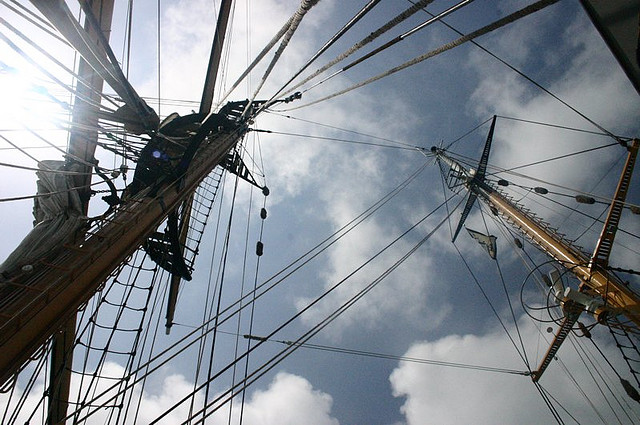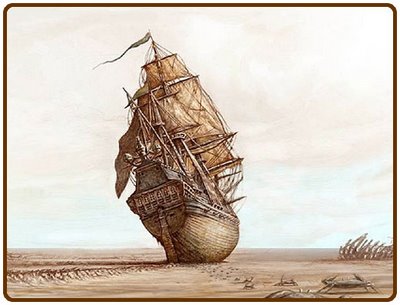Case of the Winter Doldrums Got You Down? Try Some of the Tropical Variety…
The Sargasso Sea is often conflated with the enigmas of the Bermuda Triangle, but this 2,000,000 square-mile area in the North Atlantic Ocean is mysterious enough in its own right. Large amounts of seaweed float on the top of the ocean. Apart from the seaweed, though, there is almost no life in this area; it is almost like a marine desert.
The Sea was first recorded by none other than Christopher Columbus, who believed the abundance of seaweed meant he was nearing land. In his writings, he refers to the mermaids he sees in the water. His sailors, however, were less hopeful; they were afraid they would become entangled in the jungle of seaweed.

(source)
Ancient maps used to portray the area as an island of seaweed, nothing but floating vegetation in the middle of the ocean. The area takes its name from two sources, including seaweed’s genus sargassum, and Columbus’ crew who found the plant’s bulbous air sacks to be similar to the grapes – or “sargasso” in Portuguese – grown back at home.
The unique appearance of this patch of ocean has led to a number of such myths. It was known as “the Doldrums” because of its stillness; like the eye of a hurricane, the Sargasso Sea is an area of calm that is surrounded by some of the world’s strongest ocean currents, including the Gulf Stream. Spanish adventurers found themselves floating for weeks in the impenetrable calm and were often forced to discard their horses to save water; thus, the “Horse Latitudes” were born.

(source)
In Twenty Thousand Leagues Under the Sea, Jules Verne describes the journey of a submarine through the Sargasso Sea. In Jean Rhys’ The Wide Sargasso Sea – a prequel to Jane Eyre that is considered an essential post-colonial work of fiction – Bertha, the first wife and madwoman in the attic, tells her side of the story, much of which symbolically references the titular doldrums. In his book Tristes Tropiques, anthropologist Claude Lévi-Strauss describes the deadly inertia of the Sargasso Sea:
We were approaching Le Pot-au-Noir (the Doldrums), which was greatly feared by the old navigators. the winds peculiar to both hemispheres stop on either side of this area, and the sails would hang for weeks on end without a single breath of wind to stir them into life. the air is so still that one might think oneself in some confined space instead of out on the open sea; dark clouds, with no breeze to disturb their balance, are affected only by gravity, and slowly disintegrate as they drift down towards the sea.
During the nineteenth century, many ships were lost in the area. The German ship, Meta, was found abandoned in 1881. James B. Chester was also found deserted in the Sargasso Sea. Still to this day, no one knows why…
The only landmass in the Sea is Bermuda, and the British territory is hoping to turn the area into a protected zone. Because of climate change and pollution, experts are worried about the Sargasso Sea’s long-term health. The Bermuda Institute of Ocean Sciences discovered that ‘acidification’ was occurring in the area, which could potentially prove deadly to the delicate ecosystem. Partially funded by the Sylvia Earle Alliance, efforts are underway to protect the Sargasso Sea from becoming another by-product of global change.
Have I whet your appetite just enough to want more?
- Further reading on the conservation goals of the Sylvia Earle Alliance can be found at their website.
- Every action has an equal and opposite reaction, or so I hear… Please see the Atlas entry on the Great Pacific Garbage Patch, the Sargasso Sea’s evil Pacific doppelgänger.




Follow us on Twitter to get the latest on the world's hidden wonders.
Like us on Facebook to get the latest on the world's hidden wonders.
Follow us on Twitter Like us on Facebook